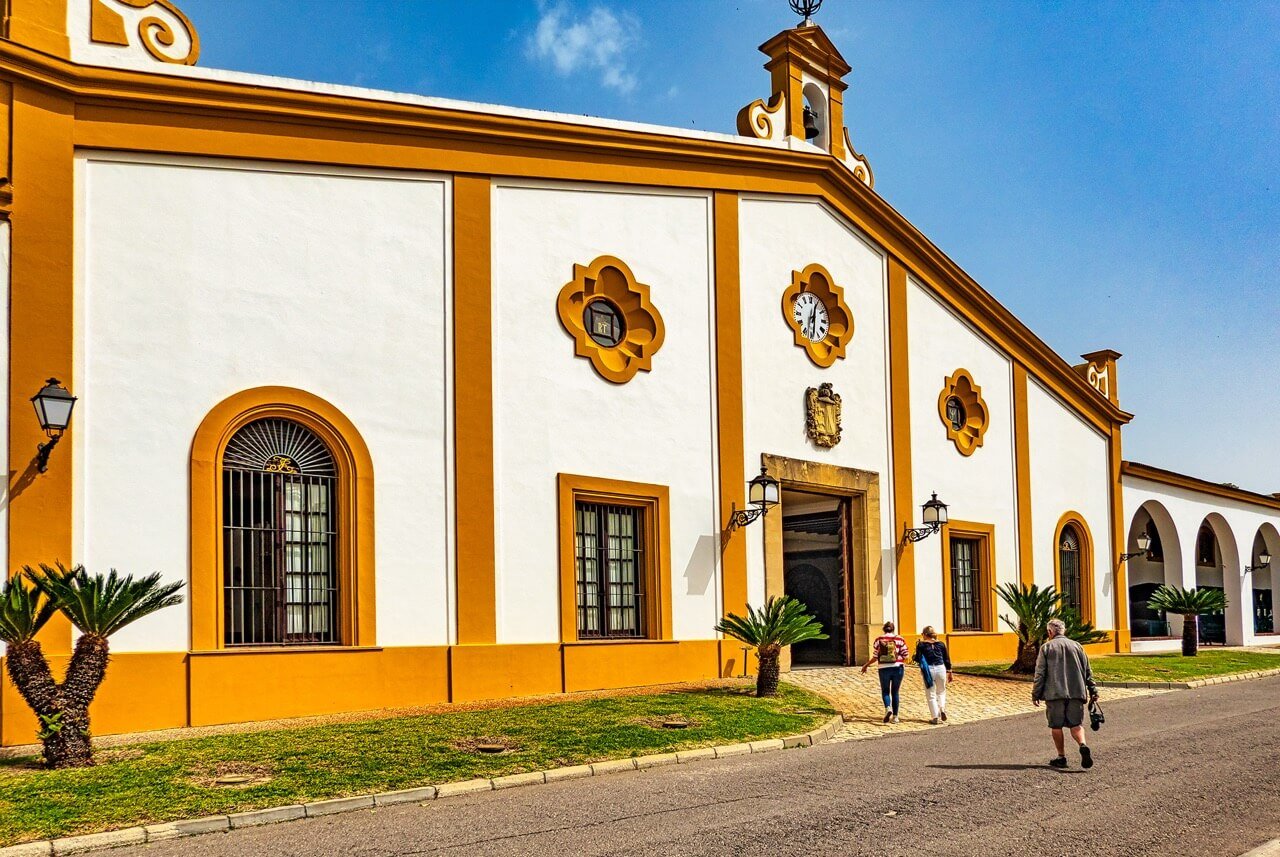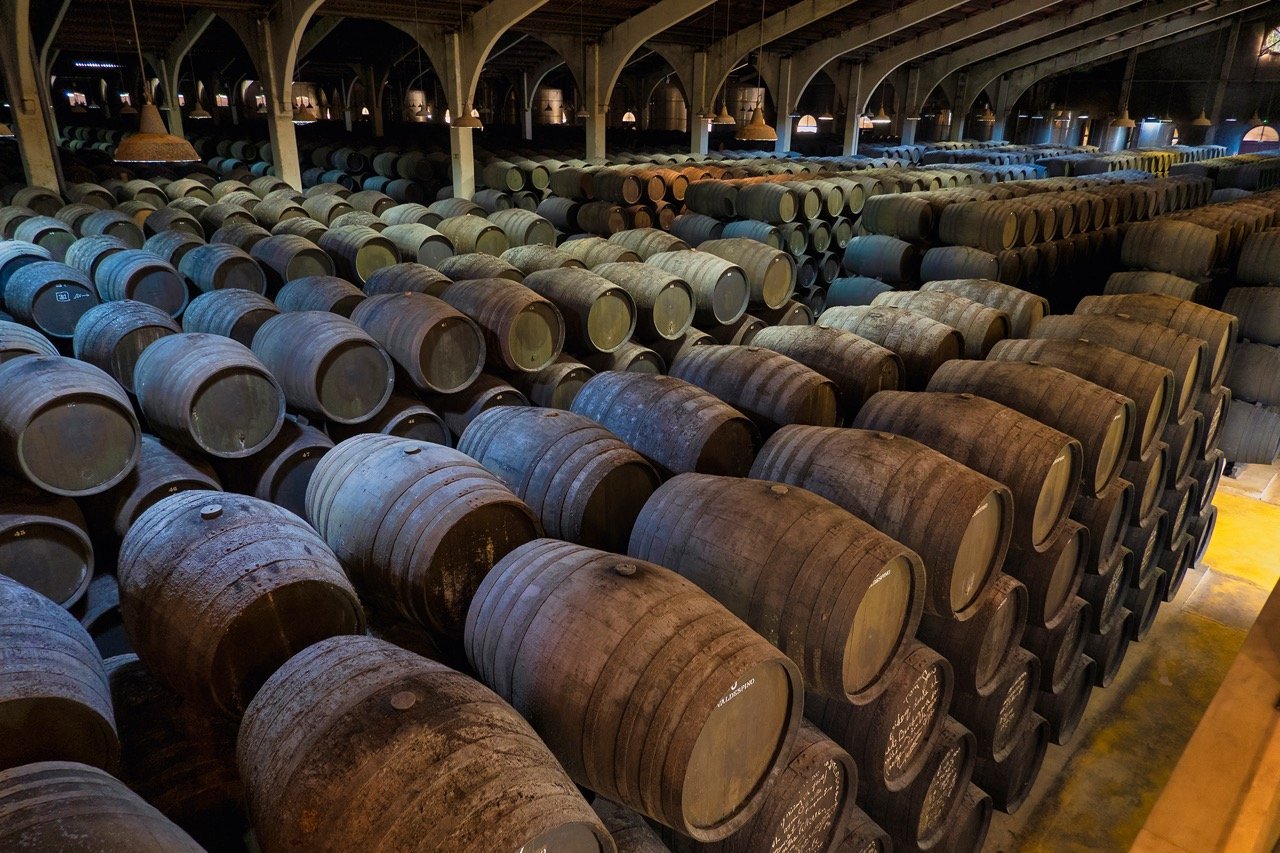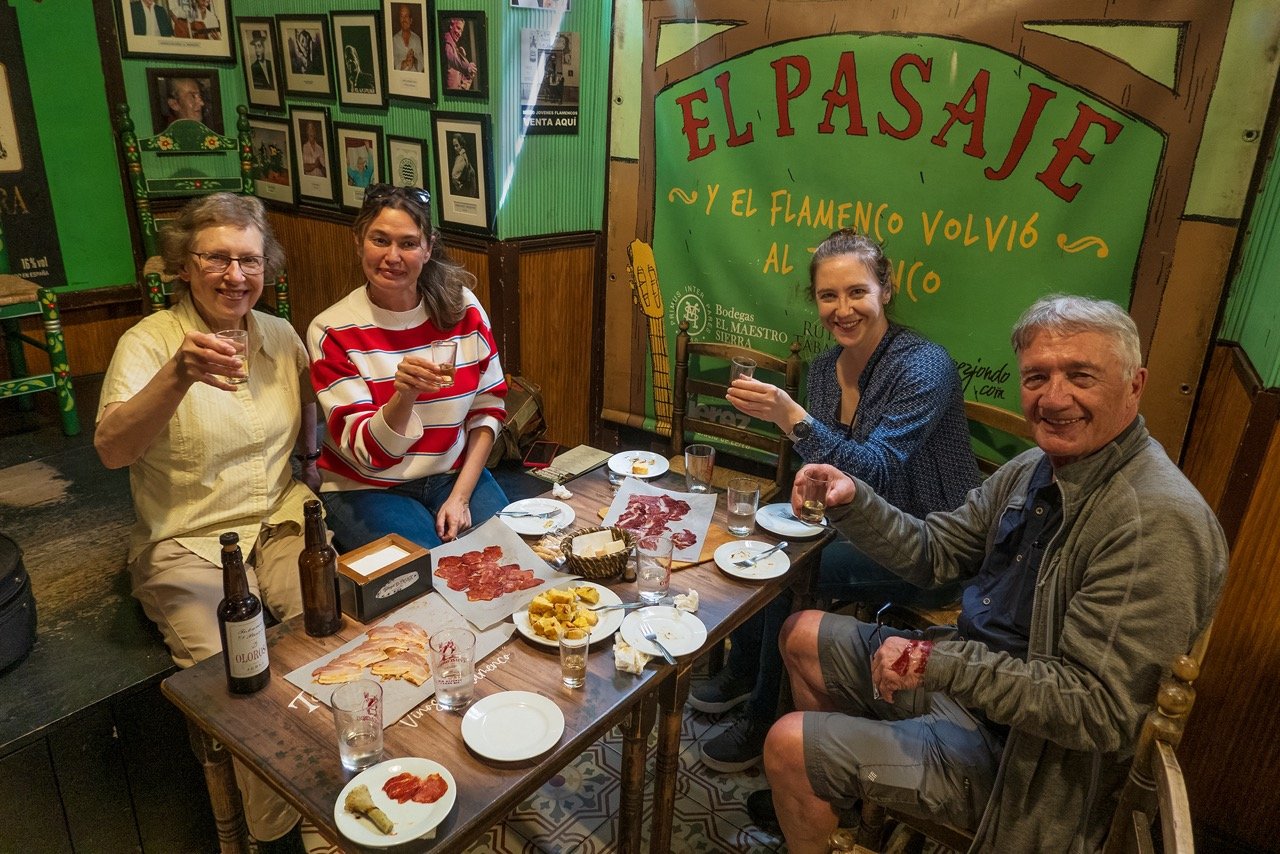Things to Do in Jerez de la Frontera: Flamenco, Sherry Bodegas and Everything in Between in Southern Spain
If you're planning a trip to southern Spain, don’t miss the opportunity to explore this city. Robin and Arlene Karpan are back with another helpful guide, highlighting the best things to do in Jerez de la Frontera—from visiting world-renowned sherry bodegas and flamenco shows, to uncovering its fascinating history and architectural gems.
Watching the Flamenco. Image Credit: Robin and Arlene Karpan
Jerez de la Frontera combines rich history with world-renowned sherries and dazzling performances in the Home of Flamenco. Surprisingly, this mid-sized city of 200,000 is sometimes overlooked by visitors to Andalucia, so far sparing it from the mass tourism common to some places in southern Spain.
That suits us just fine, leaving a pleasant, uncrowded place to wander, soak up the culture, sip sherry and get in touch with Spain’s most famous art form. Jerez isn’t simply another place for flamenco—it’s considered its home, where this combination of music, singing, and dance thrives in its purest form.
Please note that this article contains affiliate links. This means a small commission may be earned for some of the recommendations in this article, at no additional cost to you.
Getting to Jerez and Where to Stay in Frontera, Spain
Jerez sits in a rich agricultural region of Cadiz Province of southern Andalucia, just north of the historic port city of Cadiz. Seville, a bit farther north, is usually the main jumping-off point for visiting Jerez since it is only an hour away by train and only slightly longer by road.
Jerez has a wide array of accommodations from which to choose. Our base was the Hipotels Sherry Park in a modern section of town not far from the historic city centre. The 4-star property features pleasant outdoor gardens and a pool, and even has a Sherry Vermouth Bar serving vermouth made in the region, as well as a wide selection of locally produced sherries.
Central Jerez. Image Credit: Robin and Arlene Karpan
Jerez’s Long and Turbulent History
Jerez’s long history dates back to the Phoenicians, who first started producing wine. For centuries, southern Spain was divided between Christian kingdoms and Moorish Muslim-held territories. Jerez was a border town on the frontier between those territories, hence Frontera in its full formal name.
Moors occupied Jerez from the 8th century until it was captured by King Alfonso X in 1264, leaving Jerez with a mix of architecture and influences. It wasn’t until 1492 that the Moors lost their last foothold in Spain. After that, Jerez flourished due in large part to the discovery of the New World and the prominence of nearby seaports that supported traffic to and from the Americas.
In more recent times, Jerez has achieved global recognition for sherry production. The word sherry originated as an anglicized pronunciation of Jerez. The demarcated sherry region covers a relatively small area on the southern tip of Andalucia bordered by Jerez, Sanlúcar de Barrameda, and El Puerto de Santa María (also famous for providing Columbus’ flagship), where the white chalky soils provide ideal growing conditions.
Known for its long tradition in horse breeding, especially highly-prized Andalusian horses, Jerez is also home to the Royal Andalusian School of Equestrian Art, one of the most prestigious riding academies in the world.
Andalucian horses at the stud farm at Bodegas Real Tesoro, Jerez. Image Credit: Robin and Arlene Karpan
A Walk Through History in One Day
The historic city centre is easily walkable. The Alcázar or Fortress of Jerez dates back to the 11th century and has Islamic origins. Its formidable walls and towers were built for defence. Moorish rulers lived here, then after the Reconquista it became the home of the first Christian mayors. Some parts of the complex have been restored, such as the former mosque, the Arab baths, and gardens.
Also dominating the city is the huge Cathedral de Nuestro Señor San Salvador. Dating to the 17th century, the architecture combines Gothic, Baroque, and Neoclassical styles. It was built over the Great Mosque of Jerez, with the tower the only remnant of the original building.
Cathedral de Nuestro Señor San Salvador. Image credit: Robin and Arlene Karpan
Several other historic buildings, museums, and old churches dot the city centre. Another notable spot is Real Iglesia De San Dionisio Areopagita, an attractive 15th-century Gothic church. In front is one of the many pleasant sidewalk restaurants.
Sherry bodegas loom large throughout Jerez, including the city centre. Next to the cathedral stands a statue of Manuel María González, founder of González Byass, the world’s largest sherry producer. Beside him is a barrel of Tío Pepe, the company’s most famous sherry. While other cities erect statues of politicians and generals, Jerez celebrates sherry producers. No wonder we liked the place so much.
Visiting a Sherry Bodega
You can arrange visits and tours to several sherry bodegas in and around Jerez. We visited the venerable Bodegas Real Tesoro, which stands for Royal Treasure. One of the oldest wineries, it has been around since 1760, first with cellars in the centre of town, and since 1990 in the expansive grounds on the edge of Jerez. It even has a cask of sherry reserved for Spain’s royal family.
Walking through its doors is like entering a museum, with a grand piano backed by an intricate 15th-century Italian wall tapestry and several of the more than 1,000 antiques that the company owns. It was the perfect backdrop for the bodega’s guide, Juliana, to set the stage for the rest of our visit. Then it was into the cellars to see how sherry is made.
Bodegas Real Tesoro. Image credit: Robin and Arlene Karpan
Ninety-seven percent of Real Tesoro’s 940 hectares of vineyards are devoted to Palomino grapes to make Fino and other sherries, with the remainder in sweet Muscatel grapes and Pedro Ximénez grapes, which are sweeter still. Grapes are pressed into juice to begin the fermentation process at the warehouses.
Sherry undergoes a unique and complex system of aging. Called the Solera system, the bottom row of barrels holds the oldest wine, ready to be bottled. On top are the criaderas or nurseries of younger wines. One hundred litres of wine is taken from the bottom barrel for bottling, and then it is immediately filled with wine from the first criadera, which is slightly younger. It in turn is filled with wine from the second criadera which is younger still, and so on. That’s why we never see sherry coming from a specific year, because it is always a blend of wines over time.
As Juliana put it, “Every year at harvest time, a new baby comes into the family.”
About 3% of the wine evaporates, sometimes poetically referred to as the “angel’s share”, an aroma evident in the huge cellars holding some 25,000 barrels. Sherries are also fortified slightly to raise their alcohol content. Finos are usually 15%, while Olorosos and others are around 17%.
Sherry Barrels. Image credit: Robin and Arlene Karpan
Sherry Tasting
Then came the highlight of the tour - the tasting room. We started with Fino, our all-time favourite that, to us, represents the flavour of Spain. Nothing can beat sipping a chilled Fino, that pale straw-coloured sherry with a fresh sharp bouquet that is the perfect accompaniment to tapas dishes such as Iberian ham, olives, nuts, cheese, or smoked fish.
Juliana served us their best – their flagship, Fino Inocente, under the Valdespino label, which is part of Real Tesoro. Sampling this elegant wine fermented in oak barrels with grapes from a single vineyard was a rare treat that gave us insights into why wine critics rave about it.
We also tried the darker-coloured Oloroso Almirante with a distinct, almost nutty aroma. Then, the Contrabandista Medium Dry Amontillado, a slightly sweeter wine with 5% Pedro Ximenez grapes. Juliana also selected some sweet cherries, including Moscatel Promesa, a prized dessert wine. What the tour especially brought home is how varied sherries can be. Not only are there several different types and blends, but each bodega develops its specialties and taste profiles.
Wine, Art, and Horses
But a visit to Real Tesoro is about much more than wine. They also have a remarkable art gallery featuring local artists and notables such as Salvador Dali. Most impressive is the Suite Vollard, home to 100 engravings by Pablo Picasso. The collection is named after Picasso’s art dealer, Ambroise Vollard, who commissioned the series, which is now considered among the most significant collections of modern art.
Picasso Exhibit. Image credit: Robin and Arlene Karpan
The winery hallways display wildly colourful contemporary paintings portraying aspects of winemaking and the traditional Andalusian fairs and parades, usually involving horses and flamenco.
Real Tesoro’s owners are avid horse enthusiasts who take part in those fairs, often winning awards. As part of our tour, we visited the stud farm on the winery’s expansive grounds. They have 40 pure Andalusian horses, each one named after a different sherry. Near the stables, another building houses several elaborate antique carriages, the oldest from 1889, that are also used in the parades.
Experiencing a Jerez Tabanco
Spain has every type of bar you can imagine, including regional specialties. Jerez has its own peculiarity seldom seen elsewhere – the tabanco. It’s primarily a sherry bar, though other drinks, along with tapas, may be served as well. Some tabancos offer flamenco performances.
We had lunch at Tabanco El Pasaje, which opened in 1925 and is considered the oldest in Jerez. Located in the heart of the historic district, it was far and away the highlight of our visit to the city. It wasn’t just the sherry (although it was excellent), the tapas-type food (also excellent), or even the flamenco show (nothing short of spectacular). Rather it was a combination of it all and the larger experience of being in a classic Jerez tabanco.
Tobanco El Pasaje. Image credit: Robin and Arlene Karpan
Crowded, informal, and full of atmosphere, it is primarily a local haunt. Like most tabancos, sherry is served to patrons straight from the huge casks behind the bar. People also come here to buy sherry in bulk to take away. We were served fino and oloroso, both delicious, but as usual, we always came back to the fino.
Flamenco performances are free for patrons. Be prepared for a very different experience from the average flamenco show staged for the tour bus crowd. It’s more what we might expect from a town that claims to be the Home of Flamenco, with a mostly local clientele enjoying a traditional way of life as much as a show.
The performance consisted of three people: the guitar player, the singer with a powerful, haunting voice, and the dancer in a dazzling red dress who gave one of the most energetic and passionate performances we’ve seen. It was exhausting just watching her.
Flamenco in Jerez is noted for having a lot of improvisation, so it was no surprise when she left the stage and started dancing among the patrons in front of the bar. Flamenco can be intense, serious, and full of emotion, but it was obvious that the performers were totally immersed and enjoying themselves as well.
A visit to Jerez comes down to a lot of things. It’s getting in touch with a town that was on the front lines of Andalusian history. It’s the best place to appreciate Spain’s most iconic wines. And we can experience it all while being captivated by the seductive rhythms of classical flamenco.
Robin & Arlene Karpan would like to thank Tourism Spain and Tourism Andalucia for their assistance in arranging this visit. All opinions in this article are completely their own.
Robin & Arlene Karpan
Robin and Arlene Karpan are award-winning writers, photographers, bloggers, and authors of several travel books, including bestsellers. Their work has appeared in over 100 publications around the world. Robin and Arlene’s travels have taken them to all seven continents where they have a special interest in the natural world and outdoor photography. Robin and Arlene publish the popular travel blog Photo Journeys, which looks at travel through a photographer’s lens, and is rated by Feedspot as among the Top 100 Travel Photography Sites.









